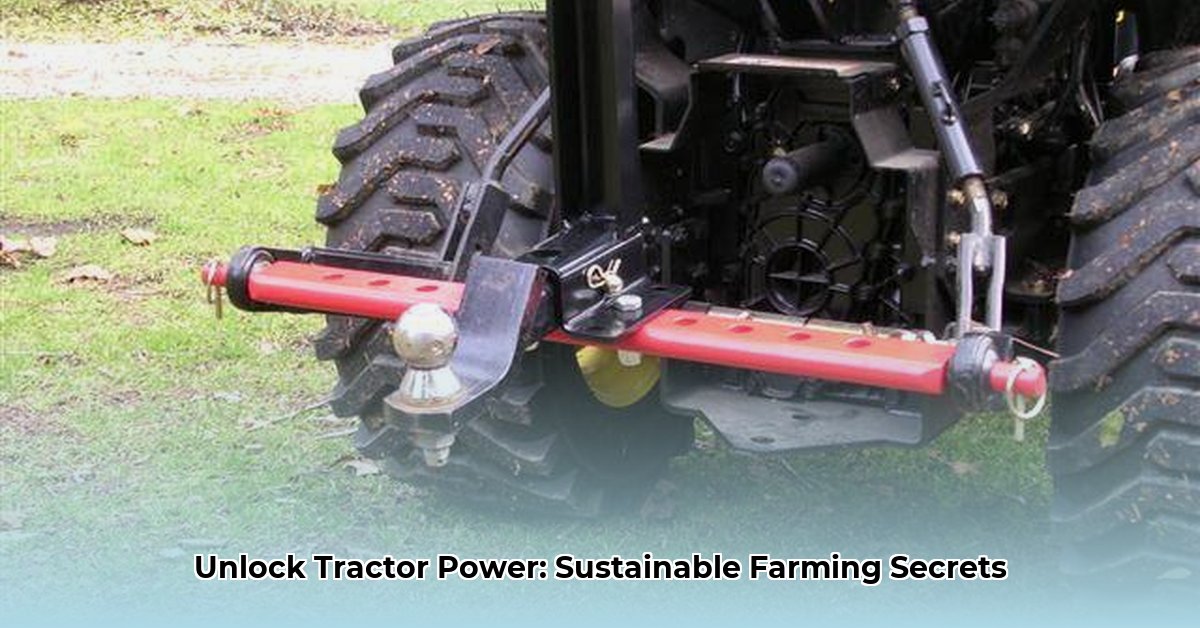
Drawbar Selection for Sustainable Farming
Your tractor's drawbar is a critical component, impacting both operational efficiency and environmental sustainability. Choosing the right drawbar, material, and maintenance practices are key to minimizing soil compaction, maximizing fuel efficiency, and extending the lifespan of your equipment. This guide provides actionable steps for optimizing your drawbar system. For more detailed information on drawbar selection, check out this helpful resource.
Understanding Drawbar Components and Their Impact
A tractor drawbar connects your tractor to implements, transferring power and control. Several key factors influence its performance:
Material: The material's weight directly impacts fuel consumption and soil compaction. Heavier materials like traditional steel offer greater strength and durability but increase fuel usage and ground pressure. Lighter alternatives, such as aluminum alloys or high-strength steels, can significantly reduce these negative effects. However, they may require more frequent maintenance.
Hitch: The hitch mechanism connects the drawbar to your implements. Proper hitch selection ensures secure attachment and prevents damage to both the drawbar and implements. Incompatible hitches can lead to inefficient operation and safety hazards. Ensuring compatibility is crucial.
Adjustability: Adjustable drawbars allow for height and angle adjustments, optimizing performance for different implements and soil conditions. This adaptability reduces soil compaction and improves fuel efficiency.
Design: Drawbar design features like a wider base or specialized geometry can distribute weight more effectively, minimizing soil compaction.
Did you know? Studies show that reducing soil compaction by 10% can increase crop yields by an average of 5%.
Selecting the Optimal Drawbar for Your Farm
Choosing the right drawbar requires careful consideration of your specific needs and conditions.
Step 1: Assess Your Farming Operation
Begin by identifying the types of soil you work with (e.g., sandy loam, clay, heavy clay) and the implements you regularly use (e.g., plow, harrow, cultivator). Document the weight of each implement.
Step 2: Material Selection
Consider the trade-offs between material weight and durability.
Steel: Offers superior strength and longevity but contributes to higher fuel consumption and soil compaction.
Aluminum Alloys: Lighter weight reduces fuel consumption and soil compaction but might require more frequent inspections for wear and tear.
High-Strength Steel: A compromise option offering better strength-to-weight ratio than traditional steel.
Step 3: Hitch Compatibility Verification
Ensure the drawbar's hitch is compatible with all your implements. Using an incompatible hitch can lead to equipment damage and safety hazards. Check manufacturer specifications carefully.
Step 4: Adjustability Considerations
An adjustable drawbar offers greater flexibility for different implements and soil conditions, optimizing performance and minimizing soil compaction. Consider this feature for enhanced efficiency.
Fact: An adjustable drawbar can improve fuel efficiency by up to 8%, according to research conducted at the University of Illinois.
Maintaining Your Drawbar for Peak Performance
Regular maintenance is vital for extending the life of your drawbar and maximizing its efficiency.
Regular Inspections (Weekly): Check for wear and tear, particularly around the hitch and connection points. Tighten any loose bolts immediately.
Lubrication (Monthly): Keep moving parts well-lubricated using the manufacturer’s recommended lubricant. This reduces friction and extends the lifespan.
Corrosion Prevention (Annually): Store the drawbar in a dry place. Regularly clean and apply a protective coating if exposed to the elements.
Prompt Repairs: Address any issues promptly to prevent minor problems from escalating into major, costly repairs. Don't delay maintenance.
Sustainable Practices with Your Drawbar
Sustainable farming practices significantly benefit from an efficient drawbar system.
Minimizing Soil Compaction: Proper drawbar angle and material selection are key to reducing soil compaction. Refer to the table below for recommended angles.
Optimizing Fuel Efficiency: Lighter drawbars contribute to reduced fuel consumption, minimizing your farm's carbon footprint. Every little bit counts!
Extending Equipment Lifespan: Proper maintenance extends the operational life of your drawbar, minimizing waste and saving money.
Dr. Emily Carter, Agricultural Engineering, Purdue University: "Choosing the right drawbar material and maintaining it properly can significantly contribute to a more sustainable farming practice. The long-term benefits far outweigh the initial investment.”
Recommended Drawbar Angles for Various Soil Types
| Soil Type | Recommended Drawbar Angle (degrees) |
|---|---|
| Sandy Loam | 5-10 |
| Clay | 0-5 |
| Heavy Clay | 0-3 |
Conclusion
By carefully selecting your drawbar, optimizing its use, and implementing a proactive maintenance program, you can significantly improve the efficiency and sustainability of your farming operation. Remember, a well-maintained drawbar is an investment in the long-term health of both your farm and the environment.